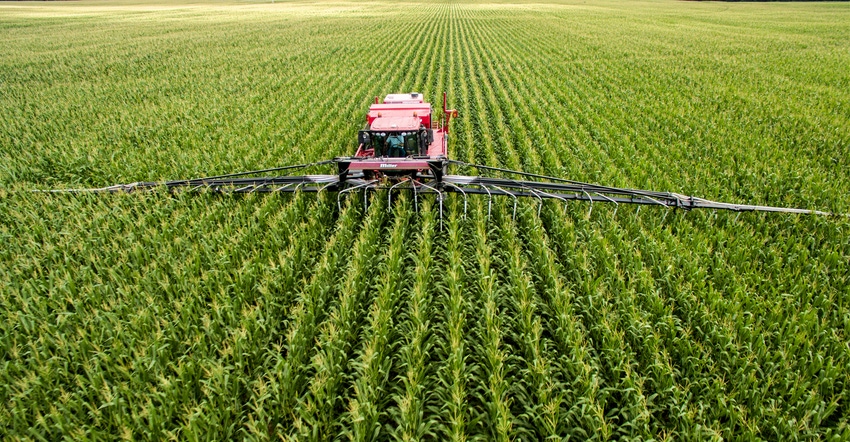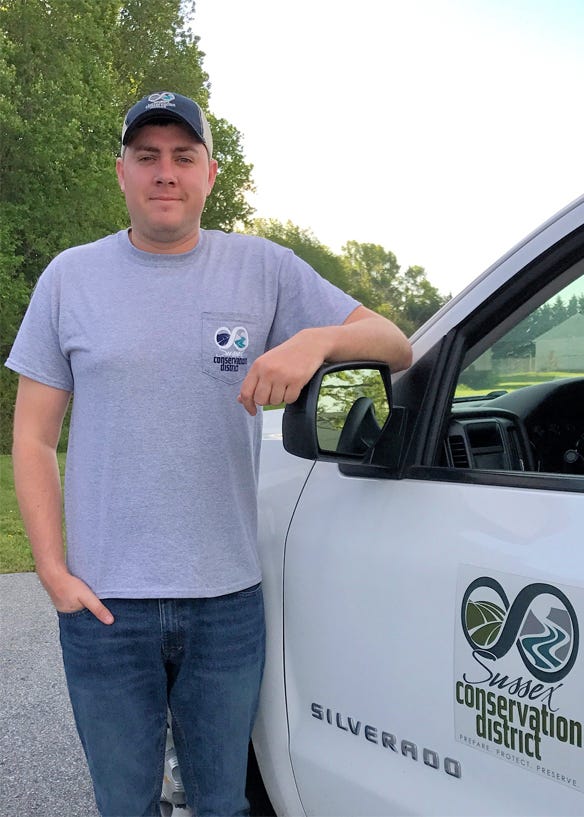
Three years ago, after being turned down for a federal Conservation Innovation Grant, Delaware’s Sussex Conservation District bought a Miller Nitro sprayer retrofitted to blow cover crop seeds beneath standing crop canopies. Delaware’s Department of Natural Resources and Environmental Control supported the initiative.
That sizable investment paid off and is revving up for a third year of its innovative Air Seeder Cost-Share Program, reports Debbie Absher, SCD’s ag program director. “Farmer interest exceeded our expectations.”
“We surpassed our goal of 4,000 acres in the first year and planted nearly 6,400 acres last year — almost a 60% increase.” And she adds: “We’re hoping to continue that trend and increase cover crop acres planted with the air seeder again this year.”
The air seeder is a modified Miller Nitro, fitted with a powered seed box and hoses to distribute cover crop seed across a 90-foot boom. Early establishment under the canopy, explains Absher, lets cover crops take advantage of summer’s longer growing degree days.
Changes for 2017
The first two years were a pilot program developed specifically for Sussex County. The program will be expanded this year, and sign-up runs through Aug. 4.
The district will charge $11 per acre for custom application of cover crops into standing cash crops such as corn, soybeans, sorghum and other vegetable crops located within the county. That covers machine, operator and fuel costs. You, the farmer, pay for the seed.
The district will contract for traveling up to 10 miles outside the county boundaries into Kent County as well as Maryland’s Caroline, Dorchester, Worcester and Wicomico counties for $12 per acre. To help control costs and ensure clean seed, four cover crop seed mixes are bought in bulk from Southern States of Dagsboro, Del. Those mixes are:
• cereal rye, radish, crimson clover
• radish and crimson clover
• cereal rye and crimson clover
• oats and winter peas
If seed is purchased through the district, it’ll be loaded at no charge. If you provide your own seed, you must have a way to load it. If a special mix is used, you’ll incur a $50 calibration fee.
First-time participants in Sussex County will receive $60 per acre for cover crops planted with the air seeder. Returning participants will receive $50 per acre. Fields outside of the county aren’t eligible for this cost-share assistance.
Instead of rushing at harvest season’s end to get cover crops planted, air seeding gives the seed a 30- to 90-day head start in getting established. And as one farmer noted: “Once you’re done with harvest, you’re done.” For more air-seeder program details, call the Sussex Conservation District office at 302-856-3990, ext. 3.
How “Plan B” gained traction
After the CIG grant proposal failed, Delaware’s state agency stepped in with additional cost-share funds to help meet the Chesapeake Bay Watershed Implementation Plan and total maximum daily load goals. That helped sway the SCD board to purchase the equipment from Buckeye Soil Solutions of Ada, Ohio.
Since most farmers were uneasy about operating it, Southern States Cooperative’s Dagsboro Store provided an operator for the first year. SCD’s Daniel Hudson took over in 2016.
“We’re bringing back [Daniel] from last year,” notes Absher. “Hudson has two years of experience loading, calibrating and running the equipment efficiently.” (See “What Hudson learned air seeding cover crops.”)
In 2015, 24 farmers participated. Seeding began on July 30 into corn and finished on Oct. 15 in soybeans. Last year, 32 farmers participated, and 6,324 acres were air seeded in this county — 4,891 acres of standing corn, 1,135 acres of soybeans and 298 acres of other crops. SCD supplied seed for about 75% of the acres.
What Hudson learned air seeding cover crops
Daniel Hudson now works full time for SCD, and remains part of a fourth-generation family farm at Millsboro, Del. After the first year of running the air seeder in 2015 as a Southern States employee, he accepted a full-time position with the conservation district.

AT THE WHEEL: Daniel Hudson expects to log a lot more hours seeding cover crop acres this summer.

He’s worked out a lot of details about cover crops and getting seed on the ground via a few growing pains — calibration issues, seed loading and seed cleanliness. Here are a few of his pointers:
• Some covers seem to take off early and go dormant if planted before there’s a crop canopy. Others seem to grow better when corn is mature and lets a little more light in between the rows.
• Timing is everything, of course, when working with Mother Nature. “Every year’s different. We can’t always answer everyone’s questions correctly because we have either been very dry or very wet during the air seeder season. But we want to continue planting as many acres as possible to get a firm look at how early planting can be taken advantage of.”
• “We know we can benefit farmers and the soil by getting the covers established early to maximize efficiency of the soil and farmers’ time.”
• The best seed mixes for air seeding can vary. Seed density and seeding rate play a big part. Heavier seeds don’t flow as well as a lighter seeds.
The district has seeding rate requirements, depending on which program you enroll in. So far, the rates used have worked really well.
“We’ve put a single species through the air seeder at a higher rate, and we’ve put up to an eight-way mix through at a lower rate,” he adds. “As long as the seed is certified clean seed, we should be able to do about any cover crop seed.”
• Farmers mistakenly assume the air seeder “runs over a mess of corn.” The answer is no. In fields planted with RTK or GPS, most actual losses are close to 1 bushel per acre, according to Buckeye Soil Solutions. “It depends on how straight they plant their rows,” concludes Hudson.
About the Author(s)
You May Also Like




